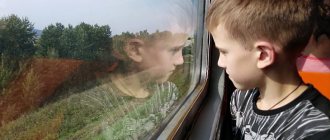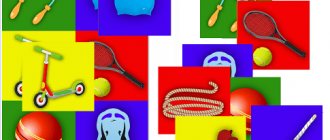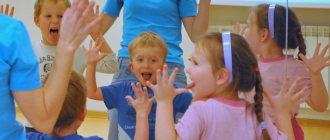Card index of outdoor games (junior group)
Katya Nikolaeva
Card index of outdoor games (junior group)
Katya Nikolaeva
Card index of outdoor games (Junior group)
Low mobility games
"Find a Pair"
Find a pair - the game develops classification and sorting skills, hand-eye coordination, hand motor skills, and thinking skills.
Progress of the game:
Objects that match each other according to some characteristics are laid out on the table. Mix them. The child is asked to take any object and find a pair for it, and then explain why he considers these objects to be paired.
Rules of the game
1. Various objects are collected that fit together (pencil and paper, sock and shoe, lock and key, etc.)
2. Lay out the items on the table and mix them.
3. The child is seated at the table.
4. An adult chooses any object and asks the child to find a pair for it (or the child chooses the object independently).
5. If the child finds a pair, it is put aside.
6. Take the next item and repeat the same thing.
7. The game continues until all the items are collected in pairs.
"Kwa-kwa-kwa"
Purpose: develops auditory memory and, to some extent, coordination of movements and attentiveness.
Progress of the game:
The leader is blindfolded with a blindfold, and the rest of the children stand around him.
The presenter begins to spin and pronounce a chant:
"Here is a frog along the path
Jumps, stretches out her legs,
She saw a mosquito and screamed.
“At the word “shout,” the leader points his fingers in front of him.
The player to whom the presenter points (or closer to whom) says: “Kwa-kwa-kwa.” The presenter must say the name of this player.
If the leader guessed correctly, then the identified player becomes the next leader, otherwise the leader repeats everything.
Rules of the game:
1. The leader is blindfolded, and the rest of the children stand around him.
2. The leader spins around and says the above speech.
3. On the word “shout”, the leader points his fingers in front of him, and the player to whom he is pointing must say: “kva-kva-kva”.
4. If the leader correctly guesses who is in front of him, then this player becomes the leader, otherwise the game starts again from the second point.
"Girls and boys"
Goal: to develop freedom and imagination in children.
Progress of the game:
Girls and boys sit opposite each other. The boys start the game. They take turns calling any girls' names. If there is a girl whose name was spoken, she stands up and says her name again and talks a little about herself. After this, it’s the girls’ turn and they start calling out the boys’ names.
Rules of the game:
1. Girls and boys sit opposite each other.
2. The boys start the game. They take turns calling any girls names
3. If there is a girl whose name was spoken, she stands up and says her name again and talks a little about herself.
4. After this, it’s the girls’ turn and they start calling out the boys’ names.
"Find by description"
Goal: To develop observation, memory and attention.
Progress of the game:
Ask your child to show you what you describe to him.
For example: “Please show me the object. It is round, one side is red and the other is blue. You can play with it: roll it, throw it to each other” (this is a ball).
Rules of the game:
1. Describe an object to the child: its color, shape, what it is made of, what can be done with it
2. The child guesses and names the object based on the description
"Ocean is shaking"
Goal: develop attention, teach to act according to the rules.
Progress of the game:
According to the number, the player places chairs in two rows so that the back of one chair touches the back of the other. All participants in the game sit on chairs. The driver says: “The sea is worried.” The players get up and run around the chairs. “The sea has calmed down,” says the driver, and the children take the empty seats. Someone will be left without a seat since one chair is occupied by the driver. The one who missed goes to drive.
Rules of the game:
1. Players are not allowed to run close to the chairs.
2. You can take an empty seat only after the words “The sea has calmed down.”
Medium mobility games
"Sun and Rain"
Goal: To develop in children the ability to perform movements at the teacher’s signal, to find their place on the playground. Practice walking and running.
Progress of the game: Children sit on chairs along the room, this is their “home”. The teacher looks out the window and says “What good weather, go for a walk!” Children get up and walk in any direction. “It’s raining, run home!” - says the teacher. Children run to the chairs and take their places. The teacher says “Drip – drip – drip!” Gradually the rain subsides and the teacher says, “Go for a walk. Rain stopped!".
Rules:
1. Children leave home at the signal “Go for a walk!”
2. They run home when the signal “it’s raining!”
"Sparrows and the car"
Goal: To develop in children the ability to perform movements on a signal. Practice running in different directions and jumping.
Progress of the game: The boundaries of the site are marked with flags. At one end of the site there are sparrows on the benches. At the other end there is a place for a car - a garage. The car is a teacher. “The sparrows are flying out of the nest!” - says the teacher, and the children begin to run in different directions, raising their arms to the sides. A car appears. The sparrows get scared and fly away to their nests. The car returns to the garage.
Rules:
1. You cannot run outside the boundaries of the site
2. Fly out of the nest only upon a signal from the teacher.
3. Return to the nests when a car appears.
"On a smooth path"
Goal: To develop in children the ability to move rhythmically, coordinate movements with words, and find their place. Practice walking, jumping, squatting, running.
Walking the game: Children sit on chairs, the teacher invites them to go for a walk. They get up, group freely or form a column. The teacher says “along the level path, our feet walk, one-two, one-two, over pebbles, over pebbles, into a hole - bang.” At the words “On a level path.” children walk at a pace. “On the pebbles” they jump on two legs, moving slightly forward. “Thump into the pit” - they squat down. They got out of the hole and the children got up. After 2-3 repetitions, the teacher says “our legs are tired along the level path, this is our home - that’s where we live.”
Rules:
1. Movements must correspond to the text.
2. Get up from your haunches after the words “We got out of the hole.”
3. Run home only after the words “that’s where we live.”
"The Mother Hen and the Chicks"
Goal: To develop in children the ability to perform movements on a signal, to practice running in different directions and crawling.
Progress of the game: Children pretend to be chickens, and the teacher pretends to be a hen. On one side of the site there is a fenced area - a house where the chickens and the hen are located (a rope is stretched between the posts at a height of 50 cm from the floor). A “big bird” is placed on the side, to the side. The hen crawls under the rope and goes in search of food. She calls the chickens - “ko-ko-ko”. At a signal, all the chickens crawl under the rope, run to the hen and walk with her around the floor. The teacher says “big bird”, all the chickens run home.
Rules:
1. At the call of the hen, all the chickens run out of the house, crawling under the rope.
2. At the “big bird” signal, the chickens must return home
"Catch a mosquito"
Goal: To develop in children the ability to coordinate movements with a visual signal, to train children in jumping (bouncing on the spot).
How to play: The players stand in a circle, at arm's length, facing the center. The teacher is in the middle of the circle. He holds in his hands a rod 1-1.2 meters long with a cardboard mosquito tied to a cord. The length of the cord is 50 cm. The teacher circles the rod and “circles the mosquito”, slightly higher than the heads of the players. When a mosquito flies overhead, the child jumps, trying to catch it. The one who grabs the mosquito says “I caught it!” Then the teacher draws a circle around the rod again.
Rules:
1. You can only catch a mosquito with both hands and jumping on two legs.
2. You need to catch a mosquito without leaving your spot.
High mobility games
"Run to me"
Goal: To teach children to act on a signal. Practice walking and running in a straight direction.
Progress of the game: Children sit on chairs placed against one of the walls of the room. The teacher moves to the opposite wall and says “run to me!” Children run to the teacher. The teacher greets them warmly. Then he goes to the other side of the site and says “run to me!” To the teacher’s words “Run home!” children sit on chairs and relax.
Rules:
1. Run to the teacher only after the words “Run to me!”
2. Children run to the chairs and sit down only after the words “Run home!”
"Catch up with me"
Goal: To develop in children the ability to perform movements at the teacher’s signal, to move in a group without pushing. Train children to run in a straight direction.
How to play: Children sit on chairs on one side of the playground. "Catch up with me!" — the teacher suggests and runs to the opposite side of the playground. Children run after the teacher, trying to catch him. Then the teacher says “catch up with me!” and runs in the opposite direction. The children catch up with him again. After two times, the children sit on chairs and rest, then continue the game.
Rules:
1. Run after the teacher only after the signal “Catch up with me!”
"Birds and Cat"
Purpose: To develop determination in children, to practice running and dodging.
Progress of the game: A circle is drawn on the ground (diameter - 7 m) or a cord is placed, the ends of which are tied. The teacher chooses one player to stand in the center of the circle. It's a cat. The rest of the children, the birds, are outside the circle. The cat is sleeping. Birds fly into a circle for grains. The cat wakes up, sees the birds and catches them. All the birds are in a hurry to fly out of the circle, the one who was touched by the cat while he was in the circle is considered caught and goes to the middle of the circle. When the cat catches 2-3 birds, the teacher chooses a new cat. The previously caught birds join the players.
Rules:
1. The cat only catches birds in a circle.
2. The cat can only touch the birds, but not grab them.
"My funny ringing ball"
Goal: To develop in children the ability to jump rhythmically, in accordance with the text of the poem, and to perform movements on a signal. Practice running and jumping on 2 legs.
Progress of the game: Children sit on chairs placed in different places in the room. The teacher is in the center. He takes a large ball and begins to hit it with his hand on the ground, saying: “My cheerful, ringing ball...”. The teacher calls the children to him and invites them to jump like balls. Children jump at the same pace. The teacher puts the ball down and repeats the poem, moving his hand as if he were hitting the ball, and the children jump. Having finished the poem, the teacher says: “I’ll catch up!” The children run away.
Rules:
1. You can only run away after the words: “I’ll catch up!”
"Find the flag"
Goal: To develop children's powers of observation and self-control (not to open their eyes until the signal “it’s time”).
Progress of the game: Children sit on chairs, at the teacher’s word, the children stand up and turn to face the wall, the teacher hides the flags according to the number of children. "It's time!" - says the teacher. The children turn to face him and go looking for flags. The one who finds the flag sits down in his place. When all checkboxes are found. Children walk along the playground. Holding a flag in your hand. The one who first found the flag goes ahead of the column. At the signal “Get to your places!” children sit on chairs and the game begins again.
Rules:
1. You can turn to face the teacher only after the word “it’s time!”
Goals and objectives of outdoor games
In the first junior group, special attention is paid to games that require varying degrees of mobility for children. Such fun is the main form of fulfilling the mission of the educational process, which consists in:
- ensuring the versatile development of children (physical, emotional-volitional, spiritual);
- health promotion;
- developing the skill to follow the rules of the game;
- stimulating the desire to play with friends and adults;
- nurturing the need to be part of a team.
Outdoor games are a collective type of work that fosters a spirit of cooperation in children.
The implementation of the set goals in the first junior group is possible with the systematic and consistent solution of the tasks of conducting outdoor games:
- strengthening the musculoskeletal system;
- mastering the skill of performing simple motor exercises together with a teacher and peers, accompanied by a simple plot;
- improving basic movements (running, walking at different paces, throwing and rolling a ball, jumping);
- learning to express movements through imitation (jumping like bunnies, drinking water like chickens, etc.);
- training the ability not to lose orientation in the playing space;
- practice the skill of moving one after another and completing the movement at a certain signal from the leader (teacher);
- developing the skill of coordinating one’s actions with the rules of the game and other participants;
- encouraging independence.
Analysis and self-analysis of outdoor games
Both types of analysis are carried out according to the same scheme, with the only difference being that the analysis is carried out by observers, whose role is played by colleagues and methodologists, and self-analysis is carried out by the teacher himself. The first assess the level of methodological literacy of the teacher when conducting the game and the preparation of children in the process of performing game actions. The teacher, through self-analysis, helps himself to identify organizational shortcomings in his work. In addition, both self-analysis and analysis assess the level of creating a positive microclimate in the children's team.
Parsing protocol
- Game start time.
- Number of players.
- Correspondence of the goals and objectives of the fun to the age of the kids.
- Who initiates the game? In the first junior group, this role is always played by the teacher.
- Techniques for creating interest in the game (riddles, explanations, showing pictures).
- Logical explanation (repetition) of the rules of the game. It is important to note whether the teacher named the location of the players and listed the attributes that the kids will need. It is important not to be distracted by comments during these explanations.
- Children’s acceptance of the rules of the game, reasons for violations (if any).
In the same paragraph, the reasons for the aggressive behavior of children during the game are analyzed, if such manifestations were
- Assessment of the level of preparation of attributes (done by the teacher himself, ready-made).
- The way to distribute roles in the game. For the first junior group, the teacher distributes them himself. In the second half of the year, it is possible to use counters to identify the characters in the game.
- The level of children’s performance of game tasks (how they overcome difficulties, whether they provide assistance, whether they show restraint).
- How developed are children's agility, speed, and endurance? It is important that kids not only perform playful movements, but also take the initiative to create combinations of actions.
- Compliance with ethical standards of behavior during the game. This criterion evaluates the manifestations of mutual assistance of young pupils in relation to each other, the development of the ability to find a common language, and the ability to give in.
- Assessing the role of the educator. How appropriate and logical are the teacher’s advice during the game, how often does he take on the role of observer.
- How does the summing up take place: does the teacher celebrate the distinguished children, does he praise everyone.
- Duration of the game and number of repetitions.
Outdoor games in the first junior group are aimed at developing physical abilities and strengthening the health of children. In addition, carrying out such fun in classes and during leisure time contributes to the socialization and development of speech in children aged 1.5–3 years. To successfully implement the assigned tasks, the teacher must take into account all the requirements for organizing and conducting outdoor games, as well as apply the maximum of his methodological knowledge to develop a detailed outline of gaming activities.




